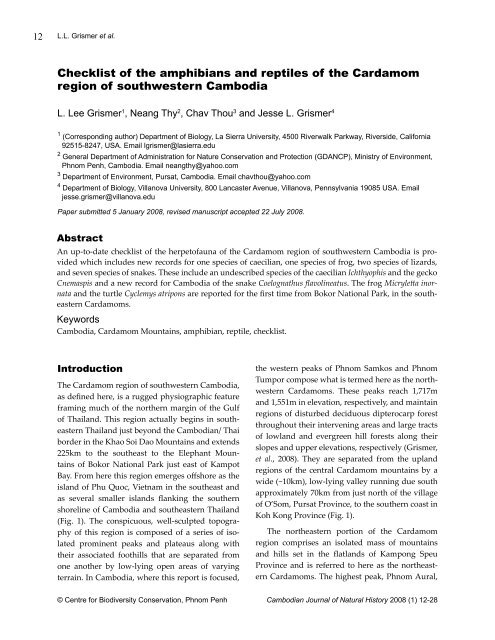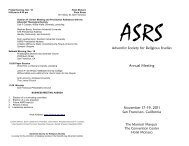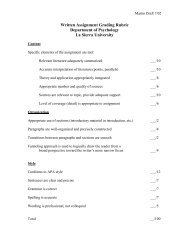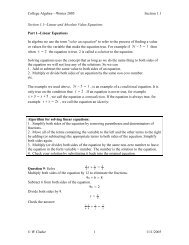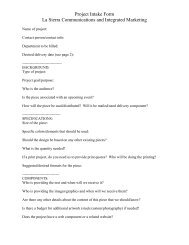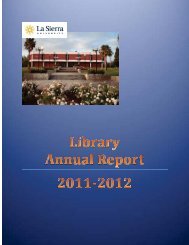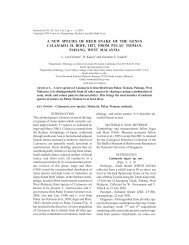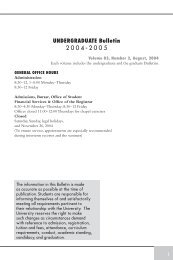Checklist of the amphibians and reptiles of the Cardamom region of ...
Checklist of the amphibians and reptiles of the Cardamom region of ...
Checklist of the amphibians and reptiles of the Cardamom region of ...
Create successful ePaper yourself
Turn your PDF publications into a flip-book with our unique Google optimized e-Paper software.
12L.L. Grismer et al.<strong>Checklist</strong> <strong>of</strong> <strong>the</strong> <strong>amphibians</strong> <strong>and</strong> <strong>reptiles</strong> <strong>of</strong> <strong>the</strong> <strong>Cardamom</strong><strong>region</strong> <strong>of</strong> southwestern CambodiaL. Lee Grismer 1 , Neang Thy 2 , Chav Thou 3 <strong>and</strong> Jesse L. Grismer 41 (Corresponding author) Department <strong>of</strong> Biology, La Sierra University, 4500 Riverwalk Parkway, Riverside, California92515-8247, USA. Email lgrismer@lasierra.edu2 General Department <strong>of</strong> Administration for Nature Conservation <strong>and</strong> Protection (GDANCP), Ministry <strong>of</strong> Environment,Phnom Penh, Cambodia. Email neangthy@yahoo.com3 Department <strong>of</strong> Environment, Pursat, Cambodia. Email chavthou@yahoo.com4 Department <strong>of</strong> Biology, Villanova University, 800 Lancaster Avenue, Villanova, Pennsylvania 19085 USA. Emailjesse.grismer@villanova.eduPaper submitted 5 January 2008, revised manuscript accepted 22 July 2008.AbstractAn up-to-date checklist <strong>of</strong> <strong>the</strong> herpet<strong>of</strong>auna <strong>of</strong> <strong>the</strong> <strong>Cardamom</strong> <strong>region</strong> <strong>of</strong> southwestern Cambodia is providedwhich includes new records for one species <strong>of</strong> caecilian, one species <strong>of</strong> frog, two species <strong>of</strong> lizards,<strong>and</strong> seven species <strong>of</strong> snakes. These include an undescribed species <strong>of</strong> <strong>the</strong> caecilian Ichthyophis <strong>and</strong> <strong>the</strong> geckoCnemaspis <strong>and</strong> a new record for Cambodia <strong>of</strong> <strong>the</strong> snake Coelognathus flavolineatus. The frog Micryletta inornata<strong>and</strong> <strong>the</strong> turtle Cyclemys atripons are reported for <strong>the</strong> first time from Bokor National Park, in <strong>the</strong> sou<strong>the</strong>astern<strong>Cardamom</strong>s.KeywordsCambodia, <strong>Cardamom</strong> Mountains, amphibian, reptile, checklist.IntroductionThe <strong>Cardamom</strong> <strong>region</strong> <strong>of</strong> southwestern Cambodia,as defined here, is a rugged physiographic featureframing much <strong>of</strong> <strong>the</strong> nor<strong>the</strong>rn margin <strong>of</strong> <strong>the</strong> Gulf<strong>of</strong> Thail<strong>and</strong>. This <strong>region</strong> actually begins in sou<strong>the</strong>asternThail<strong>and</strong> just beyond <strong>the</strong> Cambodian/ Thaiborder in <strong>the</strong> Khao Soi Dao Mountains <strong>and</strong> extends225km to <strong>the</strong> sou<strong>the</strong>ast to <strong>the</strong> Elephant Mountains<strong>of</strong> Bokor National Park just east <strong>of</strong> KampotBay. From here this <strong>region</strong> emerges <strong>of</strong>fshore as <strong>the</strong>isl<strong>and</strong> <strong>of</strong> Phu Quoc, Vietnam in <strong>the</strong> sou<strong>the</strong>ast <strong>and</strong>as several smaller isl<strong>and</strong>s flanking <strong>the</strong> sou<strong>the</strong>rnshoreline <strong>of</strong> Cambodia <strong>and</strong> sou<strong>the</strong>astern Thail<strong>and</strong>(Fig. 1). The conspicuous, well-sculpted topography<strong>of</strong> this <strong>region</strong> is composed <strong>of</strong> a series <strong>of</strong> isolatedprominent peaks <strong>and</strong> plateaus along with<strong>the</strong>ir associated foothills that are separated fromone ano<strong>the</strong>r by low-lying open areas <strong>of</strong> varyingterrain. In Cambodia, where this report is focused,<strong>the</strong> western peaks <strong>of</strong> Phnom Samkos <strong>and</strong> PhnomTumpor compose what is termed here as <strong>the</strong> northwestern<strong>Cardamom</strong>s. These peaks reach 1,717m<strong>and</strong> 1,551m in elevation, respectively, <strong>and</strong> maintain<strong>region</strong>s <strong>of</strong> disturbed deciduous dipterocarp forestthroughout <strong>the</strong>ir intervening areas <strong>and</strong> large tracts<strong>of</strong> lowl<strong>and</strong> <strong>and</strong> evergreen hill forests along <strong>the</strong>irslopes <strong>and</strong> upper elevations, respectively (Grismer,et al., 2008). They are separated from <strong>the</strong> upl<strong>and</strong><strong>region</strong>s <strong>of</strong> <strong>the</strong> central <strong>Cardamom</strong> mountains by awide (~10km), low-lying valley running due southapproximately 70km from just north <strong>of</strong> <strong>the</strong> village<strong>of</strong> O’Som, Pursat Province, to <strong>the</strong> sou<strong>the</strong>rn coast inKoh Kong Province (Fig. 1).The nor<strong>the</strong>astern portion <strong>of</strong> <strong>the</strong> <strong>Cardamom</strong><strong>region</strong> comprises an isolated mass <strong>of</strong> mountains<strong>and</strong> hills set in <strong>the</strong> flatl<strong>and</strong>s <strong>of</strong> Kampong SpeuProvince <strong>and</strong> is referred to here as <strong>the</strong> nor<strong>the</strong>astern<strong>Cardamom</strong>s. The highest peak, Phnom Aural,© Centre for Biodiversity Conservation, Phnom Penh Cambodian Journal <strong>of</strong> Natural History 2008 (1) 12-28
<strong>Cardamom</strong> <strong>region</strong> <strong>amphibians</strong> <strong>and</strong> <strong>reptiles</strong>13reaches 1,780m in elevation <strong>and</strong> maintains significanttracts <strong>of</strong> deciduous, dipterocarp forests <strong>and</strong>pristine evergreen forests (Grismer et al., 2007). Thenor<strong>the</strong>astern <strong>Cardamom</strong>s are situated due east <strong>of</strong><strong>the</strong> central portion <strong>of</strong> <strong>the</strong> <strong>Cardamom</strong> Mountains<strong>and</strong> are separated from this massif by a narrow(~5km), low-lying valley extending northwest tosou<strong>the</strong>ast for approximately 29km (Fig. 1).Between <strong>the</strong> northwestern <strong>and</strong> nor<strong>the</strong>astern<strong>Cardamom</strong>s, lies <strong>the</strong> extensive central section <strong>of</strong> <strong>the</strong><strong>Cardamom</strong> <strong>region</strong> referred to here as <strong>the</strong> central<strong>Cardamom</strong>s (Fig. 1). For <strong>the</strong> most part, this area isa high-elevation plateau reaching 1,400m in elevation<strong>and</strong> dominated by evergreen <strong>and</strong> pine forestsinfused with a network <strong>of</strong> grassl<strong>and</strong>s. Its hillyslopes maintain significant tracts evergreen <strong>and</strong>deciduous forests with fast-flowing rocky streams.Sou<strong>the</strong>ast <strong>of</strong> <strong>the</strong> central <strong>Cardamom</strong>s lies KiriromNational Park <strong>and</strong> Bokor National Park which collectivelymake up <strong>the</strong> mountainous sou<strong>the</strong>asternportion <strong>of</strong> <strong>the</strong> <strong>Cardamom</strong> Region <strong>and</strong> are referredto here as <strong>the</strong> sou<strong>the</strong>astern <strong>Cardamom</strong>s. KiriromNational Park is primarily a plateau reaching 903min elevation straddling <strong>the</strong> provinces <strong>of</strong> KampongSpeu <strong>and</strong> Koh Kong. It is separated from <strong>the</strong> central<strong>Cardamom</strong>s by a wide (~10km), low-lying flat areabeginning near <strong>the</strong> village <strong>of</strong> Choam in KampongSpeu Province <strong>and</strong> running southwest for approximately60km to Sre Ambel in Koh Kong, Province.The bulk <strong>of</strong> <strong>the</strong> Kirirom Plateau is covered with amosaic <strong>of</strong> grassl<strong>and</strong> <strong>and</strong> a reticulated network <strong>of</strong>pine forests. The slopes <strong>of</strong> <strong>the</strong> plateau support <strong>and</strong>evergreen forest interspersed with tracts <strong>of</strong> mixeddeciduous <strong>and</strong> bamboo forests. Directly sou<strong>the</strong>ast<strong>of</strong> <strong>the</strong> Kirirom Plateau is a conglomerate <strong>of</strong> hills<strong>and</strong> peaks which eventually grade into ano<strong>the</strong>rplateau <strong>region</strong> referred to as <strong>the</strong> Elephant Mountains<strong>of</strong> Bokor National Park. Reaching an elevation<strong>of</strong> 1,087m, <strong>the</strong> floral composition <strong>of</strong> this rangeFig. 1. Map <strong>of</strong> <strong>the</strong><strong>Cardamom</strong> <strong>region</strong> <strong>of</strong>Cambodia showing<strong>the</strong> survey sites(black circles) <strong>and</strong> <strong>the</strong>separate mountainsystems.Cambodian Journal <strong>of</strong> Natural History 2008 (1) 12-28© Centre for Biodiversity Conservation, Phnom Penh
14L.L. Grismer et al.is greatly affected by continuous, onshore windsarising from <strong>the</strong> Gulf <strong>of</strong> Thail<strong>and</strong> which promotea mixture <strong>of</strong> grassl<strong>and</strong> <strong>and</strong> heath forest (Stuart &Emmett, 2006) <strong>and</strong> shrouds <strong>the</strong> upper elevations<strong>of</strong> <strong>the</strong> Bokor Plateau in thick fog for much <strong>of</strong> <strong>the</strong>year. The slopes <strong>of</strong> <strong>the</strong> Elephant Mountains supporttracts <strong>of</strong> primary evergreen forests <strong>and</strong> steep, fastflowing,rocky streams.A recent surge <strong>of</strong> field surveys in <strong>the</strong> <strong>Cardamom</strong><strong>region</strong> <strong>of</strong> Cambodia have begun to reveal its extensiveherpet<strong>of</strong>aunal diversity as well as its growinglevel <strong>of</strong> endemism (Grismer et al., 2007a,b, 2008a,b;Stuart & Emmett, 2006). To date, <strong>the</strong>re is one caecilian,40 frogs, 10 turtles, 35 lizards, 51 snakes <strong>and</strong>one crocodile confirmed for <strong>the</strong> <strong>Cardamom</strong> <strong>region</strong>,<strong>the</strong> vast majority <strong>of</strong> which have been reported from<strong>the</strong> mountainous areas. Because <strong>the</strong>se mountainousareas exist as a series <strong>of</strong> fragmented, montaneecosystems with well-defined borders <strong>and</strong> differentforest types, one cannot assume that a speciesfound in one mountain range will extend continuouslythroughout this fragmented system intoo<strong>the</strong>r mountain ranges. In fact, ongoing studies <strong>of</strong><strong>the</strong> herpet<strong>of</strong>auna in <strong>the</strong> fragmented mountainous<strong>region</strong>s <strong>of</strong> <strong>the</strong> Malay Peninsula show that localizedendemism is commonplace in such areas (Grismer,in prep.). For this reason, <strong>the</strong> herpet<strong>of</strong>auna <strong>of</strong> eachmountain system are listed separately (Table 1). Previoussurveys have overlooked much <strong>of</strong> <strong>the</strong> associatedlow-lying foothill areas flanking <strong>the</strong> separatemountain systems which we report on here. This islargely because <strong>the</strong>se areas have been densely lacedwith l<strong>and</strong> mines <strong>and</strong> only a small fraction <strong>of</strong> <strong>the</strong>mhave been recently cleared.We also present <strong>the</strong> records from previous worksthat include <strong>the</strong> <strong>Cardamom</strong> <strong>region</strong> <strong>of</strong> Cambodia toprovide a complete up-to-date checklist <strong>of</strong> <strong>the</strong> herpet<strong>of</strong>auna<strong>of</strong> <strong>the</strong> entire <strong>region</strong> (Table 1). Additionalspecies records for areas <strong>of</strong> <strong>the</strong> <strong>Cardamom</strong> Regionoutside <strong>of</strong> Cambodia can be found in Bourret (1934,1942), Smith (1931, 1935, 1943) <strong>and</strong> Taylor (1963,1965, 1968) for Thail<strong>and</strong>, <strong>and</strong> to some extent PhuQuoc Isl<strong>and</strong>, Vietnam <strong>and</strong> Nguyen et al. (2005) <strong>and</strong>Dang et al. (2006) for Phu Quoc Isl<strong>and</strong>.MethodsWe conducted four brief field surveys in lowl<strong>and</strong>habitats <strong>of</strong> <strong>the</strong> western areas surrounding <strong>the</strong> villages<strong>of</strong> Che Teal Chrum, Veal Veng District, PursatProvince (12°11.898’N, 103°06.931’E; 237m abovesea level) <strong>and</strong> Pchoek Chrum, Veal Veng District,Pursat Province (12°14.341’N, 103°06.542’E; 273ma.s.l.) from 26–28 June; O’Lakmeas, Veal Veng District,Pursat Province (12°19.433’N, 103°30.605’E;96m a.s.l.) from 29 June to 1 July; <strong>the</strong> Baktra Pagoda,Veal Veng District, Pursat Province (12°25.755’N,103°51.819’E; 74m a.s.l.); <strong>and</strong> <strong>the</strong> base <strong>of</strong> PhnomSamkos at O’Peam, Veal Veng District, Pursat Province(12°12.435’N, 103°03.961’E; 271m a.s.l) from10–14 November <strong>and</strong> 7–10 December 2007. Wewere denied access into many <strong>of</strong> <strong>the</strong> o<strong>the</strong>r lowl<strong>and</strong>areas we believed had <strong>the</strong> most suitable habitat forhigh herpetological diversity (undisturbed forestwith rocky streams <strong>and</strong> rocky hillsides) because onlocation<strong>of</strong>ficials from <strong>the</strong> Cambodian Mine ActionCentre (CMAC) considered <strong>the</strong>m too dangerous.We were allowed access into areas where it wasbelieved <strong>the</strong> locations <strong>of</strong> mine fields were known<strong>and</strong> where we could be guided successfully around<strong>the</strong>m. An additional survey was conducted in <strong>the</strong>Elephant Mountains <strong>of</strong> <strong>the</strong> Bokor National Park,Kampot Province in <strong>the</strong> sou<strong>the</strong>astern portion <strong>of</strong> <strong>the</strong><strong>Cardamom</strong> <strong>region</strong> from 9–11 July 2007.Specimens were collected by h<strong>and</strong> or with ablowpipe during all hours <strong>of</strong> <strong>the</strong> day <strong>and</strong> night.Representative samples <strong>of</strong> each species collectedwere photographed prior to preservation. Followingeuthanization, tissue samples <strong>of</strong> liver weretaken <strong>and</strong> stored in 100% ethanol. Specimens were<strong>the</strong>n preserved with 10% formalin <strong>and</strong> later transferredinto 70% ethanol. Voucher material <strong>and</strong> tissuesamples were deposited in <strong>the</strong> La Sierra UniversityHerpetological Collection (LSUHC), Riverside, California,USA, unless noted o<strong>the</strong>rwise. Voucher photographswere deposited in <strong>the</strong> La Sierra UniversityDigital Photo Collection (LSUDPC).© Centre for Biodiversity Conservation, Phnom Penh Cambodian Journal <strong>of</strong> Natural History 2008 (1) 12-28
16L.L. Grismer et al.12 November. A juvenile from Popok Vil Waterfall,Bokor National Park, Kampot Province (55mmcarapace length, 48.5mm carapace width, 49.1mmplastron length, 8.2mm head depth) matches <strong>the</strong>characterization <strong>of</strong> this species (Stuart & Platt, 2004)in having a yellow plasteron with densely pigmentedbridges; an immaculate chin; <strong>and</strong> 12 dark <strong>and</strong>11 light ventral neck stripes. Stuart & Platt (2004)noted that ventral neck stripes were more variable<strong>and</strong> this specimen exceeds <strong>the</strong> known range <strong>of</strong> bothstripes by two.An adult (LSUDPC 4066) from a shallow streamat O’Peam was identified, <strong>and</strong> released.The taxonomic history <strong>of</strong> this species is not clear(Fritz et al., 2001; Guicking et al., 2002; Stuart & Platt,2004) <strong>and</strong> its specific separation from Cyclemyspulchrastriata on <strong>the</strong> basis <strong>of</strong> morphology alone isdubious in <strong>the</strong> absence <strong>of</strong> locality data (Guickinget al., 2002; Stuart & Platt, 2004). Fritz et al. (2008)<strong>and</strong> Stuart <strong>and</strong> Fritz (2008), however, demonstratedwith genetic markers that C. pulchrastriata<strong>and</strong> C. atripons form two distinct lineages. Severalspecimens <strong>of</strong> C. atripons have been reported from<strong>the</strong> Koh Kong Province in <strong>the</strong> central <strong>Cardamom</strong>s(Stuart & Platt, 2004), but <strong>the</strong>se are <strong>the</strong> first recordsfrom Bokor National Park <strong>and</strong> O’Peam.LSUHC 8567 was found at 1100h in a small,water-filled, rocky depression (7cm x 6cm x 1cm),3cm from <strong>the</strong> edge <strong>of</strong> a sheer, rock cliff approximately40m in height bordering a large waterfall.AgamidaeDraco indochinensis Smith 1928The type locality <strong>of</strong> this species is <strong>the</strong> Bokor Mountains,Bokor National Park, <strong>of</strong> <strong>the</strong> sou<strong>the</strong>astern <strong>Cardamom</strong>s(Smith, 1928). It has also been reportedfrom hilly eastern Cambodia at O’Rang, MondolkiriProvince (Stuart et al., 2006). It was overlooked in<strong>the</strong> checklist <strong>of</strong> Grismer et al. (2007a).Pseudocalotes floweri (Boulenger, 1912)Material examined: Bokor National Park(10°37.142’N, 104°05.218’E), 862m a.s.l., LSUHC8572; 7 July.Smith (1935) reported this species from “Bokor,Elephant Mnts, 3,000 feet” which would fall within<strong>the</strong> Bokor National Park. We collected a juvenilefemale (SVL 55mm) which corresponds to thisspecies (Hallerman & McGuire, 2001) by lackinglarge postorbital <strong>and</strong> nuchal spines; having anexposed tympanum; no blue pigment lining <strong>the</strong>oral mucosa; having a red gular pouch; havingdorsal scales larger than ventrals; having enlargedkeels on <strong>the</strong> anterior edges <strong>of</strong> <strong>the</strong> subdigital lamellae<strong>of</strong> <strong>the</strong> third toe <strong>and</strong> <strong>the</strong> posterior edges beingreduced; having keeled gular scales with a small,granular, gular sac; having four canthal scalesbetween <strong>the</strong> nasal <strong>and</strong> anteriormost supranasal; 53scales around midbody; <strong>and</strong> no white spotting on<strong>the</strong> elbows or knees.This specimen was collected at 2300h duringa rainstorm while it was sleeping 3.5m above <strong>the</strong>ground at <strong>the</strong> end <strong>of</strong> a thin, horizontal branch inevergreen forest. This species was not reported fromBokor National Park by Grismer et al. (2007a).GekkonidaeCnemaspis sp. (Fig. 3).Material examined: O’Lakmeas Village, LSUHC8478, 8485, 30 June 2007; LSUHC 8515–17, 1 July.Grismer et al. (2007a) reported Cnemaspischanthaburiensis from Phnom Samkos in <strong>the</strong> northwestern<strong>Cardamom</strong>s. Reported here is a series <strong>of</strong> fiveadult specimens (three females [SVL 49.0–56.1mm]<strong>and</strong> two males [SVL 50.0–53.9mm]) which cannotbe ascribed to any <strong>of</strong> <strong>the</strong> known sou<strong>the</strong>ast Asianspecies (Grismer & Ngo, 2007; Chan & Grismer,2008; Grismer & Chan, 2008; Grismer et al., 2008)based on <strong>the</strong>m having scales <strong>of</strong> <strong>the</strong> anterior portion<strong>of</strong> <strong>the</strong> forearm keeled; smooth ventral scales; oneor two precloacal pores in males; no femoral pores;no rows <strong>of</strong> linearly arranged tubercles on flanks;having paravertebral <strong>and</strong> lateral longitudinal rows<strong>of</strong> caudal tubercles; smooth subcaudals with anenlarged median row; two or three cloacal tubercles;no large, shield-like subtibial scales; enlargedsubmetatarsal scales beneath <strong>the</strong> first metatarsal;<strong>and</strong> a dull-white, thin, chevron-shaped collar. This© Centre for Biodiversity Conservation, Phnom Penh Cambodian Journal <strong>of</strong> Natural History 2008 (1) 12-28
18L.L. Grismer et al.Fig. 8 Naja siamensis from Pchoek Chrum (photo by LLG).population is being described as a new species(Grismer et al., in prep.).All specimens were collected between 2000<strong>and</strong> 2300h along a rocky ridge atop a low hill indry deciduous forest mix with st<strong>and</strong>s <strong>of</strong> bamboo.Specimens were seen on large, vertical faces <strong>and</strong> insmall caves. This population occurs 47.3km nor<strong>the</strong>ast<strong>of</strong> <strong>the</strong> Phnom Samkos population <strong>of</strong> Cnemaspischanthaburiensis.ScincidaeEutropis longicaudatus (Hallowell, 1857) (Fig. 4).Material examined: O’Lakmeas Village, LSUHC8480, 30 June.One adult male (SVL 101mm) corresponds toTaylor’s (1963) description in having dorsal scaleswith two or three low, smooth keels; a scaly lowereyelid lacking a transparent disc; postnasal <strong>and</strong>supranasal scales; medial contact <strong>of</strong> <strong>the</strong> prefrontals;well developed limbs with foot reaching palm whenlegs are adpressed; <strong>and</strong> a wide, dark brown, lateralstripe bordered above <strong>and</strong> below by a white line. Itdiffers from Taylor’s (1963) description in having 32scales around midbody as opposed to 26–30.This specimen was collected at 1100h whilebasking on a pile <strong>of</strong> wood along a dirt road.Although Eutropis longicaudatus has a wide distributionthroughout Indochina <strong>and</strong> <strong>the</strong> Malay Peninsula(Taylor, 1963), this is <strong>the</strong> first report <strong>of</strong> thisspecies from <strong>the</strong> <strong>Cardamom</strong> <strong>region</strong> <strong>of</strong> Cambodia.ColubridaeBoiga siamensis Nootp<strong>and</strong> 1971Material examined: O’Lakmeas Village, LSUHC8502, 8527, 6 June <strong>and</strong> 1 July, respectively.Two adult females (SVL 1,050mm <strong>and</strong> 1,250mm)are in moderate accordance with Kroon’s (1973)original diagnosis in have 23 dorsal scale rows atmidbody; 270–280 ventrals (247–270 in Kroon, 1973);90–126 divided subcaudals (116–129 in Kroon,1973); eight supralabials with <strong>the</strong> third, fourth, <strong>and</strong>fifth entering <strong>the</strong> orbit; one preocular not contact-© Centre for Biodiversity Conservation, Phnom Penh Cambodian Journal <strong>of</strong> Natural History 2008 (1) 12-28
<strong>Cardamom</strong> <strong>region</strong> <strong>amphibians</strong> <strong>and</strong> <strong>reptiles</strong>19ing <strong>the</strong> frontal; two postoculars; two (LSUHC 8527<strong>and</strong> Kroon, 1973) or three (LSUHC 8502) anteriortemporals; 12 or 13 infralabials; enlarged vertebralscales; <strong>and</strong> an entire anal plate.Both specimens were collected between 2000<strong>and</strong> 2200h. LSUHC 8502 was found 1m above <strong>the</strong>ground on a branch in a degraded secondary drydeciduous forest <strong>and</strong> LSUHC 8527 was found2m above <strong>the</strong> ground in a tree alongside a smallstream.This species was originally described as Boigaocellata Kroon, 1973 but was shown to be a juniorsynonym <strong>of</strong> B. siamensis Nootp<strong>and</strong> 1971 by Pauwelset al. (2005). This species represents a new recordfor <strong>the</strong> northwestern <strong>Cardamom</strong>s.Coelognathus flavolineatus (Schlegel, 1837) (Fig. 5).Material examined: O’Peam, LSUHC 8693–94, 12November.Two adults males (SVL 1,314mm <strong>and</strong> 1,210mm)match Smith’s (1943) <strong>and</strong> Taylor’s (1965) descriptionhaving a large loreal; sixth labial contactingeye <strong>and</strong> temporal scales; dorsal scales on posteriortwo-thirds <strong>of</strong> body strongly keeled; 19 dorsal scalerows at midbody; dark suborbital spots; no dark,transverse nuchal b<strong>and</strong>; black, dorsolateral stripesanteriorly. Posterior part <strong>of</strong> body <strong>and</strong> tail black.Both specimens were collected at night whilecrawling across open ground along a stream bankin lowl<strong>and</strong> evergreen forest. This Malayan speciesranges north into central Thail<strong>and</strong> (Schulz, 1996) <strong>and</strong>has been reported from central Vietnam (Szyndlar& Nguyen, 1996). Although this is <strong>the</strong> first record<strong>of</strong> Coelognathus flavolineatus for Cambodia, it is notunexpected.Dryocalamus davisonii (Blanford, 1878)Material examined: O’Lakmeas Village, LSUHC8479, 6 June.A subadult female (SVL 578mm) is in accordancewith Smith’s (1943) description <strong>and</strong> that <strong>of</strong>specimens from <strong>the</strong> central <strong>and</strong> sou<strong>the</strong>astern <strong>Cardamom</strong>s(Stuart & Emmett, 2006) in having 13 rows<strong>of</strong> smooth, dorsal scales at midbody; no preocular;loreal in broad contact with eye; one postocular; 30dark brown interspaces on body (elongate anteriorly<strong>and</strong> shortened posteriorly) separated by 29cream-coloured b<strong>and</strong>s; <strong>and</strong> 22 dark caudal b<strong>and</strong>s(19–21 in Stuart & Emmett, 2006).The specimen was collected at 2200h, 2m above<strong>the</strong> ground during its head-down descent <strong>of</strong> <strong>the</strong>trunk <strong>of</strong> a small tree alongside a small stream.Although this species has been reported from<strong>the</strong> central <strong>and</strong> sou<strong>the</strong>astern <strong>Cardamom</strong>s (Stuart& Emmett, 2006), this is <strong>the</strong> first report from <strong>the</strong>northwestern <strong>Cardamom</strong>s.Lycodon laoensis Gün<strong>the</strong>r 1864Material examined: O’Lakmeas Village, LSUHC8481, 6 June.An adult female matches <strong>the</strong> diagnosis <strong>of</strong> thisspecies as presented by Daltry & Wüster (2002:500)in having 185 ventrals; 66 divided subcaudals; adivided anal plate; a single preocular <strong>and</strong> loreal;loreal not contacting eye, but contacting internasal;two postoculars; two anterior temporals; 10 supralabials(nine reported by Daltry & Wüster, 2002); 18light b<strong>and</strong>s on body (19–36 reported in Daltry &Wüster, 2002); <strong>and</strong> 17 rows <strong>of</strong> smooth dorsal scalerows at midbody.This specimen was collected at 2000h whilecrawling on a stream bank 3m from <strong>the</strong> water’sedge. Although this species has been reported from<strong>the</strong> central <strong>and</strong> nor<strong>the</strong>astern <strong>Cardamom</strong>s (Swan &Daltry, 2002), this is <strong>the</strong> first report from <strong>the</strong> northwestern<strong>Cardamom</strong>s.Oligodon sp. (Fig. 6).Material examined: O’Lakmeas Village, LSUHC8534; 1 July.This specimen was collected at 1100h whilecrawling along <strong>the</strong> edge <strong>of</strong> a rocky stream. It hasbeen previously reported from Che Teal ChrumVillage (Grismer et al., 2008a).Oligodon fasciolatus (Gün<strong>the</strong>r, 1864) (Fig. 7).Material examined: O’Lakmeas Village, LSUHC8482; 30 June.Cambodian Journal <strong>of</strong> Natural History 2008 (1) 12-28© Centre for Biodiversity Conservation, Phnom Penh
20L.L. Grismer et al.Table 1 <strong>Checklist</strong> <strong>of</strong> <strong>the</strong> herpet<strong>of</strong>auna <strong>of</strong> <strong>the</strong> <strong>Cardamom</strong> <strong>region</strong> <strong>of</strong> southwestern Cambodia.Northwest Central Nor<strong>the</strong>ast Sou<strong>the</strong>astCAECILIANSIchthyopidaeIchthyophis sp. 12 10FROGSMegophryidae 2,7Leptolalax sp.Megophrys auralensis Ohler, Swan & Daltry 2002 3 2,7BufonidaeBufo macrotis Boulenger 1887 2 2,3,6,8 2,10Bufo melanostictus Schneider 1799 2 2,3,6 2,7,10Ingerophrynus parvus Boulenger 1887 2 8MicrohylidaeCalluella guttulata (Blyth 1855) 12 3Kalophrynus interlineatus (Blyth 1855) 11 2,3,7 2Kaloula pulchra Gray 1831 2 2,6,8 2,7,10Microhyla annamensis Smith 1923 2 2Microhyla berdmorei (Blyth 1856) 2,11 2 13Microhyla butleri Boulenger 1900 2 2,3,6 2,7,10Microhyla fissipes (Duméril, Bibron & Duméril 1841) 2 2Microhyla heymonsi Vogt 1911 2 2,3,6 2,7,10 14Microhyla pulchra (Hallowell 1861) 2 2,3 2,7,10Micryletta inornata (Boulenger 1890) 2 3 12RanidaeFejervarya cancrivora (Gravenhorst 1829) 10Fejervarya limnocharis (Gravenhorst 1829) 1,2 2,6,8 2,7Hoplobatrachus chinensis (Osbeck 1756) 2 6 2,7Limnonectes gyldenstolpei (Anderson 1916) 1,2Limnonectes kohchangae (Smith 1922) 2 2,3,8 2,7,10 3Occidozyga lima (Gravenhorst 1829) 2 3 2,7,10Occidozyga martensii Peters 1867 2 2,3,6,8 2,7,10Paa fasciculispina (Inger 1970) 2 3 2,7,11Rana erythraea (Schlegel 1837) 2,3,6,8 2,7 3Rana faber Ohler, Swan & Daltry 2002 2,11 2,3,6 2,7 3Numbers refer to references for <strong>the</strong> areas indicated: 1 = Daltry & Chheang (2000); 2 = Ohler et al. (2002); 3 =Stuart & Emmett (2006); 4 = Stuart & Platt (2004); 5 = seen but not vouchered; 6 = Long et al. (2001); 7 = Swan& Daltry (2002); 8 = Daltry & Traeholt (2003); 9 = Chuaynkern et al. (2004); 10 = Grismer et al. (2007a); 11 =Grismer et al. (2008a); 12 = this report; 13 = Smith (1916); 14 = Bourret (1942); 15 = Platt et al. (2003); 16 = Tirant(1884); 17 = Paive (1904); 18 = Smith (1931); 19 = Smith (1935); 20 = Smith (1928); 21 = Müster (1983); 22 = Peters(1971); 23 = Saint Girons (1972); 24 = Smith (1943); 25 = Bourret (1934); 26 = Malhotra et al. (2004).© Centre for Biodiversity Conservation, Phnom Penh Cambodian Journal <strong>of</strong> Natural History 2008 (1) 12-28
<strong>Cardamom</strong> <strong>region</strong> <strong>amphibians</strong> <strong>and</strong> <strong>reptiles</strong>21Rana macrodactyla (Gün<strong>the</strong>r 1859) 2,6Northwest Central Nor<strong>the</strong>ast Sou<strong>the</strong>astRana milleti Smith 1921 11 3 9Rana mortenseni Boulenger 1903 2,11 2,6 2,7 3Rana taipehensis van Denburgh 1909 2 2RhacophoridaeChiromantis doriae Boulenger 1893 2,6Chiromantis nongkhorensis (Cochran 1927) 11 3 10 3Chiromantis samkosensis Grismer, Neang, Chav & 11Holden 2007Chiromantis vittatus (Cochran 1927) 2 3,6 2,7Philautus cardamonus Ohler, Swan & Daltry 2002 2,11Philautus parvulus (Boulenger 1893) 1 2,7,10 3Polypedates cf. leucomystax (Gravenhorst 1829) 11 2 2,7,10Rhacophorus bipunctatus Ahl 1927 11 3 2,7,10Rhacophorus bisacculus Taylor 1962 2,11 3 3Theloderma asperum (Boulenger 1886) 2,7Theloderma stellatum Taylor 1962 3TURTLESBataguridaeBatagur baska (Gray 1831 "1830–35") 4,15,16,17Cuora amboinensis (Daudin 1802) 1 1,4 7,10Cyclemys atripons Iverson & McCord 1997 12 1,4,7 12Heosemys gr<strong>and</strong>is (Gray 1860) 4,18Malayemys subtrijuga (Schlegel & Miller 1844) 4Siebenrockiella crassicollis (Gray 1831) 4TestudinidaeIndotestudo elongata (Blyth 1853) 1,4,6,18 9,10Manouria impressa (Gün<strong>the</strong>r 1882) 1 1TrionychidaeAmyda cartilaginea (Boddaert 1770) 1,4 1,8 7Pelochelys cantori Gray 1864 1CROCODYLIACrocodylidaeCrocodylus siamensis (Müller 1838) 11 1,6,8SQUAMATA (LIZARDS)AgamidaeAcanthosaura cf. crucigera Boulenger 1885 1 3,8 9,10 3,19Calotes emma Gray 1845 1 1,3,6,8 7Calotes mystaceus Duméril & Bibron 1837 1 1,8 7 3Calotes versicolor (Daudin 1802) 1 3,6,8 7,10 3Cambodian Journal <strong>of</strong> Natural History 2008 (1) 12-28© Centre for Biodiversity Conservation, Phnom Penh
22L.L. Grismer et al.Northwest Central Nor<strong>the</strong>ast Sou<strong>the</strong>astDraco indochinensis Smith 1928 12,20,21Draco maculatus (Gray 1845) 1 3,8 7,10 3Draco taeniopterus Gün<strong>the</strong>r 1861 1 3 7,10Physignathus cocincinus Cuvier 1829 1,10 1,3,6 7,10 3Pseudocalotes floweri (Boulenger 1912) 12,19GekkonidaeCnemaspis chanthaburiensis Bauer & Das 1996 11Cnemaspis sp. 12Cyrtodactylus intermedius (Smith 1917) 1 3 7,10 3,19Dixonius siamensis (Boulenger 1898) 1 1,6 10Gekko gecko (Linnaeus 1758) 1 3,6 7,10Gehyra mutilata (Wiegmann 1834) 12 10Hemidactylus frenatus Duméril & Bibron 1836 1 1 7,10 12Hemidactylus platyurus (Schneider 1792) 11 10Hemiphyllodactylus cf. yunnanensis (Boulenger 1903) 11Ptychozoon lionotum Annadale 1905 3 3LacertidaeTakydromus sexlineatus Daudin 1802 11 3ScincidaeEutropis longicaudatus (Hallowell 1857) 12Eutropis macularius (Blyth 1853) 1 3,6,8 7,10Eutropis multifasciatus (Kuhl 1820) 12 1,3,6,8 10Lipinia vittigera (Boulenger 1894) 1 1,3,6 7,10 3Lygosoma bowringii (Gün<strong>the</strong>r 1864) 1 3 7,10 3Lygosoma quadrupes (Linnaeus 1766) 1Scincella melanosticta (Boulenger 1887) 1 1,3,6,8 10 3Scincella rufocaudata (Darevsky & Nguyen 1983) 3Scincella sp. 11Sphenomorphus indicus (Gray 1853) 1 8 7,11Sphenomorphus maculatus (Blyth 1853) 1 3,6 7,11 3Sphenomorphus stellatum (Boulenger 1900) 3LeiolepididaeLeiolepis belliana (Gray 1827) 22 5,7VaranidaeVaranus nebulosus Gray 1831 1 7Varanus salvator Laurenti 1768 1 1,6 7SQUAMATA (SNAKES)TyphlopidaeRamphotyphlops braminus (Daudin 1803) 1 23Typhlops diardii Schlegel 1839 11 1,6© Centre for Biodiversity Conservation, Phnom Penh Cambodian Journal <strong>of</strong> Natural History 2008 (1) 12-28
<strong>Cardamom</strong> <strong>region</strong> <strong>amphibians</strong> <strong>and</strong> <strong>reptiles</strong>23Typhlops muelleri Schlegel 1839 3Northwest Central Nor<strong>the</strong>ast Sou<strong>the</strong>astXenopeltidaeXenopeltis concolor Reinwardt in Boie 1827 3 3PythonidaePython reticulatus Schneider 1801 11ColubridaeAhaetulla nasuta (Lacépede 1789) 1,10Ahaetulla prasina (Reinwart in Boie 1827) 1 1,3,6,23 7 12Amphiesma boulengeri (Gressitt 1937) 1,11 3 10 23,24Boiga cyanea (Duméril, Bibron & Duméril 1854) 11 3,23 3Boiga dendrophila (Boie 1827) 3 3Boiga multomaculata (Boie 1827) 3 7 3Boiga siamensis Nootp<strong>and</strong> 1971 12 3Chrysopelea ornata (Shaw 1802) 1 3 10 3Coelognathus flavolineatus (Schlegel 1837) 12Coelognathus radiatus (Boie 1827) 1,6 25 23Dendrelaphis pictus Gmelin (1789) 1 23 7Dendrelaphis subocularis (Boulenger 1888) 10Dryocalamus davisonii (Blanford 1878) 12 3 3Dryophiops rubescens (Gray in Gray & Hardwicke11835)Enhydris bocourti (Jan 1865) 3 25Enhydris plumbea (Boie 1827) 11 1,6,8 24Gonyosoma oxycephalum (Boie 1827) 1,3Homalopsis buccata (Linnaeus 1758) 1 1,3,6,23 3,25Lycodon cardamomensis Daltry & Wüster 2002 1Lycodon laoensis Gün<strong>the</strong>r 1864 12 7Oligodon barroni (Smith 1916) 1Oligodon sp. 11,12Oligodon fasciolatus (Gün<strong>the</strong>r 1864) 12 23Oligodon inornatus (Boulenger 1914) 1 3Oreophis porphyraceus (Cantor 1839) 1Orthriophis taeniurus (Cope 1861) 1Pareas carinatus (Boie 1828) 1,3,8 3,23Pareas margaritophorous (Jan, 1866) 11 3 10Psammodynastes pulverulentus (Boie 1827) 1 1,3,6,8,23 10 12,23Ptyas korros (Schlegel 1837) 1 8,23 7Ptyas mucosus (Linnaeus 1758) 10Rhabdophis chrysargos (Schlegel 1837) 1 1,3,6,23 10Rhabdophis nigrocinctus (Blyth 1856) 1 3 10Rhabdophis subminiatus (Schlegel 1837) 1 1,6 7 23Cambodian Journal <strong>of</strong> Natural History 2008 (1) 12-28© Centre for Biodiversity Conservation, Phnom Penh
24L.L. Grismer et al.Northwest Central Nor<strong>the</strong>ast Sou<strong>the</strong>astSibynophis collaris (Gray 1853) 1Xenochrophis flavipunctatus (Hallowell 1860) 1 1,6 7Xenochrophis trianguligerus (Boie 1827) 3ElapidaeBungarus c<strong>and</strong>idus (Linnaeus 1758) 1 1,6 23Bungarus fasciatus (Schneider 1801) 1 10,23Naja kaouthia Lesson 1831 1Naja siamensis Laurenti 1768 12Ophiophagus hannah (Cantor 1836) 1ViperidaeCalloselasma rhododstoma (Boie 1827) 10 3,23 7Cryptelytrops albolabris (Gray 1842) 1 3,23 7,10 25Cryptelytrops macrops (Kramer 1997) 1 3 7 3Viridovipera vogeli (David, Vidal & Pauwels 2001) 1,26 3 7,10 26An adult female (SVL 550mm) matches Werner’s(1925) description <strong>and</strong> Saint Girons’ (1972) exp<strong>and</strong>eddescription <strong>of</strong> Oligodon cyclurus smithi. Wagner(1975) however, demonstrated in an unpublished<strong>the</strong>sis, that O. c. smithi <strong>and</strong> O. c. superfluens werejunior synonyms <strong>of</strong> Oligodon fasciolatus (Gün<strong>the</strong>r,1864). Although not published, this taxonomy wasfollowed by Pauwels et al. (2003) <strong>and</strong> is followedhere as well. LSUHC 8482 has a single, large loreal;two pre- <strong>and</strong> postoculars; eight supralabials <strong>and</strong>nine infralabials; 21 midbody dorsal scale rows;162 ventrals; <strong>and</strong> 52 subcaudals. It differs from O.fasciolatus (sensu Saint Girons, 1972; Taylor, 1965) inhaving 10 as opposed to 14–17 ovoid, brown, dorsalblotches edged in black.This specimen was collected at 1200h whilecrossing a trail 20m from a rocky stream. Thisspecies is widespread throughout Indochina <strong>and</strong>its first report here from <strong>the</strong> <strong>Cardamom</strong> <strong>region</strong> isnot unexpected.Psammodynastes pulverulentus (Boie, 1827)Material examined: Popok Vil Waterfall, BokorNational Park, Kampot Province (10°39.429’N,104°03.091’E), 925m a.s.l. LSUHC 8568; 7 July.An adult male (SVL 294mm) agrees with Smith’s(1943) <strong>and</strong> Taylor’s (1965) description in having<strong>the</strong> third maxillary tooth enlarged, followed bya diastema with <strong>the</strong> last series <strong>of</strong> maxillary teethbeing fang-like <strong>and</strong> grooved; canthus sharplyangular; frontal narrow; nostril in a single nasalscale; 17 dorsal scale rows at midbody; 60 ventrals;54 divided subcaudals; <strong>and</strong> anal plate entire.The specimen was collected at 1100h whilecrossing a dirt road running through a grassy fieldnear <strong>the</strong> Popok Vil Waterfall. Although this speciesis widely distributed throughout <strong>the</strong> <strong>Cardamom</strong><strong>region</strong>, this is <strong>the</strong> first record for Bokor NationalPark.ElapidaeNaja siamensis Laurenti 1768 (Fig. 8).Material examined: Pchoek Chrum, LSUHC 8408;26 June.A juvenile female (SVL 270mm) matches <strong>the</strong>modified diagnosis <strong>of</strong> Wüster & Thorpe (1994)in having a slightly elongate frontal scale with apointed posterior margin; a single cuneate scalebetween <strong>the</strong> fourth <strong>and</strong> fifth supralabials on eachside; 169 ventrals <strong>and</strong> 21 subcaudals; 21 midbody© Centre for Biodiversity Conservation, Phnom Penh Cambodian Journal <strong>of</strong> Natural History 2008 (1) 12-28
<strong>Cardamom</strong> <strong>region</strong> <strong>amphibians</strong> <strong>and</strong> <strong>reptiles</strong>25dorsal scale rows; V-shaped hood marking; <strong>and</strong>a dull as opposed to shiny overall appearance <strong>of</strong>scales.This specimen was found coiled beneath aboard along <strong>the</strong> side <strong>of</strong> a dirt road running throughdegraded dry deciduous forest following anafternoon rain. This species is widely distributedthroughout Indochina (Wüster & Thorpe, 1994) <strong>and</strong>its first recorded occurrence here in <strong>the</strong> <strong>Cardamom</strong><strong>region</strong> is not surprising.DiscussionThe discovery <strong>of</strong> Icthyophis sp., Calluella guttalata,Cyclemys atripons, Boiga siamensis, Dryocalamus davisonii,<strong>and</strong> Lycodon laoensis in <strong>the</strong> northwestern <strong>Cardamom</strong><strong>region</strong> is not unexpected given that <strong>the</strong>yhave been previously reported from o<strong>the</strong>r areasin <strong>the</strong> <strong>Cardamom</strong> Mountains (Daltry & Chheang,2000; Swan & Daltry, 2002; Stuart & Platt, 2004;Stuart & Emmett, 2006; Grismer et al., 2007). Much<strong>the</strong> same is true for Eutropis longicaudatus, Coelognathusflavolineatus, Oligodon fasciolatus <strong>and</strong> Naja siamensiswhich are widespread throughout Indochina(Taylor, 1963; Saint Girons, 1972; Wagner, 1975;Wüster & Thorpe, 1994; Schulz, 1996; Szyndlar &Nguyen, 1996; Pauwels et al., 2003) but are reportedhere for <strong>the</strong> first time in <strong>the</strong> <strong>Cardamom</strong> <strong>region</strong>.Additionally, this is <strong>the</strong> first report <strong>of</strong> Coelognathusflavolineatus for Cambodia. Also widespreadthroughout <strong>the</strong> <strong>Cardamom</strong> <strong>region</strong> are Micrylettainornata, Cyclemys atripons, <strong>and</strong> Psammodynastes pulverulentus,but are reported here for <strong>the</strong> first timefrom <strong>the</strong> Bokor National Park.Most surprising is <strong>the</strong> new species <strong>of</strong> Cnemaspisfrom a lowl<strong>and</strong>, rocky area in a heavily degradeddry deciduous forest only 47.3km nor<strong>the</strong>ast <strong>of</strong>C. chanthaburiensis from <strong>the</strong> nor<strong>the</strong>astern foot <strong>of</strong>Phnom Samkos (Grismer et al., 2008a). This, <strong>and</strong><strong>the</strong> o<strong>the</strong>r discoveries underscore <strong>the</strong> unexplorednature <strong>of</strong> <strong>the</strong>se lowl<strong>and</strong> areas despite <strong>the</strong>ir highlydegraded nature. With <strong>the</strong> clearing <strong>of</strong> additionalmine fields in <strong>the</strong>se areas allowing access to morebiological surveys, it is expected that additionalnew records <strong>and</strong> new species will be found.AcknowledgementsWe wish to thank Dr Mok Mareth, Senior Minister <strong>of</strong><strong>the</strong> Ministry <strong>of</strong> <strong>the</strong> Environment, <strong>and</strong> Chay Samith,Director <strong>of</strong> <strong>the</strong> General Department <strong>of</strong> Administrationfor Nature Conservation <strong>and</strong> Protection, forproviding research permits. For field assistance wethank Narin Srei, T. Duncan, <strong>and</strong> D. Potts. Fauna& Flora International, <strong>the</strong> Association for CulturalExchange, <strong>and</strong> <strong>the</strong> Zoological Parks & GardensBoard <strong>of</strong> Victoria provided support for Neang Thy<strong>and</strong> Chav Thou. For useful comments on <strong>the</strong> manuscriptwe thank B. Stuart, J. Holden, <strong>and</strong> J. Daltry.Partial support was provided to L. Lee Grismer bya grant from <strong>the</strong> Collage <strong>of</strong> Arts <strong>and</strong> Sciences, LaSierra University.ReferencesBerry, P.Y. (1975) The Amphibian Fauna <strong>of</strong> PeninsularMalaysia. Tropical Press, Kuala Lumpur, Malaysia.Bourret, R. (1934) Notes herpétologiques surL’Indochine, Française. IV. Sur une collectiond’ophidiens de Cochinchine et du Cambodge.Bulletin Général de l’Instruction Publique, 1, 13–25.Bourret, R. (1942) Les Batrachiens de L’Indochine.Institut Océanographique de l’Indochine, Hanoi,Vietnam.Chan, K.O. & Grismer, L.L. (2008) A new species<strong>of</strong> Cnemaspis Strauch 1887 (Squamata: Gekkonidae)from Selangor, Peninsular Malaysia. Zootaxa,1877, 49-57.Chuaynkern, Y., Ohler, A., Inthra, C., Kumtong,P. & Dubois, A. (2004) The recent distribution<strong>of</strong> Rana milleti Smith, 1921 in mainl<strong>and</strong> Sou<strong>the</strong>astAsia with <strong>the</strong> first record <strong>of</strong> Cambodia. TheNatural History Journal <strong>of</strong> Chulalongkorn University,4, 1–13.Daltry, J.C. & Chheang, D. (2000) Reptiles. In <strong>Cardamom</strong>Mountains Biodiversity Survey 2000 (edsDaltry, J.C. & Momberg, F.), Fauna & Flora International,Cambridge, UK.Cambodian Journal <strong>of</strong> Natural History 2008 (1) 12-28© Centre for Biodiversity Conservation, Phnom Penh
26L.L. Grismer et al.Daltry, J.C. & Traeholt, C. (2003) Reptile <strong>and</strong>amphibian survey. In Biodiversity Assessment <strong>of</strong><strong>the</strong> Sou<strong>the</strong>rn <strong>Cardamom</strong>s <strong>and</strong> Botum-Sakor Peninsula(eds Daltry, J.C. & Momberg, F.), pp. 82–100<strong>and</strong> Appendices III <strong>and</strong> IV. WildAid: CambodiaProgram, <strong>and</strong> Department <strong>of</strong> Forestry <strong>and</strong> Wildlife,Phnom Penh, Cambodia.Daltry, J.C. & Wüster, W. (2002) A new species <strong>of</strong>wolf snake (Serpentes: Colubridae: Lycodon) from<strong>the</strong> <strong>Cardamom</strong> Mountains, southwestern Cambodia.Herpetologica, 58, 498–504.Dang, H.P., Nguyen, Q.T., Nguyen, T.S., & Nguyen,V.K. (2006) Mammals, Reptiles <strong>and</strong> Amphibians <strong>of</strong>Phu Quoc Isl<strong>and</strong>, Kien Giang Provence, Vietnam.Wildlife at Risk, Ho Chi Minh City, Vietnam.Fritz, U., Guicking, D., Auer, M. Sommer, R.S.,Wink, M. & Hundsdörfer, A.K. (2008) Diversity<strong>of</strong> <strong>the</strong> Sou<strong>the</strong>ast Asian leaf turtle genus Cyclemys:how many leaves on its tree <strong>of</strong> life? ZoologicaScripta, 2008, 1¬20.Fritz, U., Guicking, D., Wink, M. & Lehr, E. (2001)Sind Cyclemys atripons Iverson & McCord, 1997und Cyclemys pulchristriata Fritz, Gaulke & Lehr,1997 identisch? Sauria, 23, 33–38.Gower, D.J., Kupfer, A., Oommen, O.V., Himstedt,W., Nussbaum, R.A., Loader, S.P., Presswell, B.,Müller, H., Krishna, S.P., Boistel, R. & Wilkinson,M. (2002) A molecular phylogeny <strong>of</strong> ichthyophiidcaecilians (Amphibia: Gymnophiona: Ichthyophiidae):Out <strong>of</strong> India or out <strong>of</strong> sou<strong>the</strong>ast Asia?Proceedings <strong>of</strong> <strong>the</strong> Royal Society B, 269, 1563–1569.Grismer, L.L. & Chan, K.O. (2008) A new species <strong>of</strong>Cnemaspis Strauch 1887 (Squamata: Gekkonidae)from Pulau Perhentian Besar, Terengganu, PeninsularMalaysia. Zootaxa, 1771, 1-15.Grismer, L.L. & Ngo V.T. (2007) Four new species <strong>of</strong><strong>the</strong> gekkonid genus Cnemaspis Strauch 1887 (Reptilia:Squamata) from sou<strong>the</strong>rn Vietnam. Herpetologica,63, 482–500.Grismer, L.L., Chav T., Neang T., Wood Jr, P.L.,Grismer, J.L., Youmans, T.M., Ponce, A., Daltry,J.C. & Kaiser, H. (2007a) The herpet<strong>of</strong>auna <strong>of</strong> <strong>the</strong>Phnom Aural Wildlife Sanctuary <strong>and</strong> checklist <strong>of</strong><strong>the</strong> herpet<strong>of</strong>auna <strong>of</strong> <strong>the</strong> <strong>Cardamom</strong> Mountains,Cambodia. Hamadryad, 31, 216–241.Grismer, L.L., Neang T., Chav T. & Holden, J.(2007b) A new species <strong>of</strong> Chiromantis Peters 1854(Anura: Rhacophoridae) from Phnom Samkos in<strong>the</strong> northwestern <strong>Cardamom</strong> Mountains, Cambodia.Herpetologica, 63, 392-400.Grismer, L.L., Neang T., Chav T. Wood Jr, P.L.,Oaks, J.R., Holden, J., Grismer, J.L., Szutz, T.R.& Youmans, T.M. (2008a) Additional <strong>amphibians</strong><strong>and</strong> <strong>reptiles</strong> from <strong>the</strong> Phnom Samkos WildlifeSanctuary in <strong>the</strong> northwestern <strong>Cardamom</strong>Mountains, Cambodia, with comments on <strong>the</strong>irtaxonomy <strong>and</strong> <strong>the</strong> discovery <strong>of</strong> three new species.The Raffles Bulletin <strong>of</strong> Zoology, 56, 161-175.Grismer, L.L., Chan K.O., Nurolhuda N. &Sumontha, M. (2008b) A new species <strong>of</strong> karstdwelling gecko (genus Cnemaspis Strauch 1887)from <strong>the</strong> border <strong>region</strong> <strong>of</strong> Thail<strong>and</strong> <strong>and</strong> PeninsularMalaysia. Zootaxa, 1875, 51-68.Guicking, D., Fritz, U., Wink, M. & Lehr, E. (2002)New data on <strong>the</strong> diversity <strong>of</strong> <strong>the</strong> Sou<strong>the</strong>ast Asianleaf turtle genus Cyclemys Bell, 1834. Molecularresults (Reptilia: Testudines: Geomydidae*).Faunistische Abh<strong>and</strong>lungen Staatliches Museum fürTierkunde Dresden, 23, 75–86.Hallermann, J. & McGuire, J.A. (2001) A newspecies <strong>of</strong> Pseudocalotes (Squamata: Agamidae)from Bukit Larut, West Malaysia. Herpetologica,57, 255–265.Kroon, C. (1973) A new colubrid snake (Boiga) fromsou<strong>the</strong>astern Asia. Copeia, 1973, 580–586.Lim, K.K.P. & Lim, L.J. (1999) The terrestrial herpet<strong>of</strong>auna<strong>of</strong> Pulau Tioman, Peninsular Malaysia.The Raffles Bulletin <strong>of</strong> Zoology Supplement Number6, 131–156.Long, B., Swan, R.S., Tith B. & Ay R. (2002) Rapidconservation assessment <strong>of</strong> <strong>the</strong> large mammals,birds, <strong>reptiles</strong> <strong>and</strong> <strong>amphibians</strong> <strong>of</strong> <strong>the</strong> Veal Vengwetl<strong>and</strong>. In Social <strong>and</strong> Ecological Surveys <strong>of</strong> <strong>the</strong>Veal Veng Wetl<strong>and</strong>, <strong>Cardamom</strong> Mountains, Cambodia,with Special Reference to <strong>the</strong> Conservation <strong>of</strong> <strong>the</strong>Siamese Crocodile (ed. Daltry, J.C), pp. 34–37. CambodiaProgramme, Fauna & Flora International,Phnom Penh, Cambodia.© Centre for Biodiversity Conservation, Phnom Penh Cambodian Journal <strong>of</strong> Natural History 2008 (1) 12-28
<strong>Cardamom</strong> <strong>region</strong> <strong>amphibians</strong> <strong>and</strong> <strong>reptiles</strong>27Malhotra, A., Stuart, B.L., & Thorpe, R.S. (2004)A morphometric analysis <strong>of</strong> Trimeresurus vogeli(David, Vidal <strong>and</strong> Pauwels, 2001), with new dataon diagnostic characteristics, distribution <strong>and</strong>natural history. Herpetological Journal, 14, 65–77.Man<strong>the</strong>y, U. & Grossmann, W. (1997) Amphibien &Reptilien Südostasiens. Natur und Tier – Verlag,Germany.Muster, G.J.M. (1983) Taxonomy <strong>of</strong> <strong>the</strong> genus DracoL. (Agamidae, Lacertilia, Reptilia). ZoologischeVerh<strong>and</strong>elingen, 199, 1–120.Nguyen, V.S., Ho, T.C., & Nguyen, Q.T. (2005) A<strong>Checklist</strong> <strong>of</strong> Amphibians <strong>and</strong> Reptiles <strong>of</strong> Vietnam. NhaXuat Ban Nong Nghiep, Hanoi, Vietnam.Ohler, A., Swan, S.R. & Daltry, J.C. (2002) A recentsurvey <strong>of</strong> <strong>the</strong> amphibian fauna <strong>of</strong> <strong>the</strong> <strong>Cardamom</strong>Mountains, southwest Cambodia with descriptions<strong>of</strong> three new species. The Raffles Bulletin <strong>of</strong>Zoology, 50, 465–481.Parker, H.W. (1934) A Monograph <strong>of</strong> <strong>the</strong> Frogs <strong>of</strong><strong>the</strong> Family Microhyldae. Trustees <strong>of</strong> <strong>the</strong> BritishMuseum. London.Pauwels, O.S.G., David, P., Chanhome, L., Vogel,G., Chan-ard, T. & Orlov, N. (2005) On <strong>the</strong> status<strong>of</strong> Boiga ocellata Kroon, 1973, with <strong>the</strong> designation<strong>of</strong> a neotype for Boiga siamensis Nootp<strong>and</strong>, 1971(Serpentes, Colubridae). Russian Journal <strong>of</strong> Herpetology,12, 102–106.Pauwels, O.S.G., David, P., Chimsunchart, C. &Thirakhupt, K. (2003) Reptiles <strong>of</strong> PhetchaburiProvince, western Thail<strong>and</strong>: a list <strong>of</strong> species, withnatural history notes, <strong>and</strong> a discussion on <strong>the</strong>biogeography at <strong>the</strong> Isthmus <strong>of</strong> Kra. The NaturalHistory Journal <strong>of</strong> Chulalongkorn University, 3,23–53.Pavie, A. (1904) Mission Pavie Indo-Chine 1879–1895: Études Diverses. III. Recherches sur L’HistorieNaturelle de L’Indo-Chine Orientale. Ernest Leraux,Paris.Peters, G. (1971) Die intragenerischen gruppenund die phylogenese der schmetterlingsagamen(Agamidae: Leiolepis). Zoologische Jahrbücher (Systematik)Bd., 98, 11–30.Platt, S.G., Stuart, B.L, Heng S., Long K., Kalyar& Heng K. (2003) Rediscovery <strong>of</strong> <strong>the</strong> criticallyendangered river terrapin, Batagur baska, in Cambodia,with notes on occurrence, reproduction,<strong>and</strong> conservation status. Chelonian Conservation<strong>and</strong> Biology, 4, 691–695.Saint Girons, H. (1972) Les serpents du Cambodge.Mémoires du Muséum National d’Historie Naturelle,Paris, Nouvelle Série, A, Zooloige, 74, 1–170.Schulz, K.-D. (1996) A Monograph <strong>of</strong> <strong>the</strong> ColubridSnakes <strong>of</strong> <strong>the</strong> Genus Elaphe Fitzinger. Koeltz ScientificBooks, Havlickuv Brod, Czech Republic.Smith, M.A. (1916) On a collection <strong>of</strong> <strong>reptiles</strong> <strong>and</strong>batrachians from peninsular Siam. Journal <strong>of</strong> <strong>the</strong>Natural History Society <strong>of</strong> Siam, 2, 148–171.Smith, M.A. (1928) Description <strong>of</strong> a new species <strong>of</strong>Draco from <strong>the</strong> Indo-Chinese Region. Annals <strong>of</strong> <strong>the</strong>Magazine <strong>of</strong> Natural History, 10, 248.Smith, M.A. (1931) The Fauna <strong>of</strong> British India, includingCeylon <strong>and</strong> Burma. Reptilia <strong>and</strong> Amphibia. Vol. ILoricata, Testudines. Taylor <strong>and</strong> Francis, London,UK.Smith, M.A. (1935) The Fauna <strong>of</strong> British India, IncludingCeylon <strong>and</strong> Burma. Reptilia <strong>and</strong> Amphibia. Vol. IISauria. Taylor <strong>and</strong> Francis, London, UK.Smith, M.A. (1943) The Fauna <strong>of</strong> British India, IncludingCeylon <strong>and</strong> Burma, including <strong>the</strong> whole <strong>of</strong> <strong>the</strong>Indo-Chinese sub-<strong>region</strong>. Reptilia <strong>and</strong> Amphibia. Vol.III Serpentes. Taylor <strong>and</strong> Francis, London, UK.Stuart, B.L. & Emmett, D.A. (2006) A collection <strong>of</strong><strong>amphibians</strong> <strong>and</strong> <strong>reptiles</strong> from <strong>the</strong> Elephant <strong>and</strong><strong>Cardamom</strong> Mountains, southwestern Cambodia.Fieldiana Zoology (New Series), 109, 1–27.Stuart, B.L. & Fritz, U. (2008) Historical DNA frommuseum type specimens clarifies diversity <strong>of</strong>Asian leaf turtles (Cyclemys). Biological Journal <strong>of</strong><strong>the</strong> Linnean Society, 94, 131–141.Stuart, B.L. & Platt, S.G. (2004) Recent records<strong>of</strong> turtles <strong>and</strong> tortoises from Laos, Cambodia,<strong>and</strong> Vietnam. Asiatic Herpetological Research, 10,129–150.Stuart, B.L., Sok, K. & Neang, T. (2006) A collection<strong>of</strong> <strong>amphibians</strong> <strong>and</strong> <strong>reptiles</strong> from hilly easternCambodian Journal <strong>of</strong> Natural History 2008 (1) 12-28© Centre for Biodiversity Conservation, Phnom Penh
28L.L. Grismer et al.Cambodia. Raffles Bulletin <strong>of</strong> Zoology, 54, 129–155.Swan, R.S. & Daltry, J,C. (2002) Reptiles <strong>and</strong> <strong>amphibians</strong>.In Social <strong>and</strong> Ecological Surveys <strong>of</strong> PhnomAural Wildlife Sanctuary, <strong>Cardamom</strong> Mountains,Cambodia, (ed. J.C. Daltry), pp. 23–40. CambodiaProgramme, Fauna & Flora International, <strong>and</strong> <strong>the</strong>Ministry <strong>of</strong> Environment, Phnom Penh.Szyndlar, Z. & Nguyen, V.S. (1996) Terrestrial snakefauna <strong>of</strong> Vietnam, distributional records. TheSnakes, 27, 27–28.Taylor, E.H. (1963) The lizards <strong>of</strong> Thail<strong>and</strong>. University<strong>of</strong> Science Kansas Bulletin, 44, 687–1077.Taylor, E.H. (1965) The serpents <strong>of</strong> Thail<strong>and</strong> <strong>and</strong>adjacent waters. University <strong>of</strong> Science Kansas Bulletin,45, 609–1096.Taylor, E.H. (1968) The Caecilians <strong>of</strong> <strong>the</strong> World. University<strong>of</strong> Kansas Press, Lawrence Kansas, USA.Tirant, G. (1884) Notes sur les <strong>reptiles</strong> de laCochinchina et du Cambodge. Excursions etReconnaissances, 8, 147–168.Wagner, F.W., III. (1975) A revision <strong>of</strong> <strong>the</strong> Asian colubridsnakes Oligodon cinereus (Gün<strong>the</strong>r), Oligodonjoynsoni (Smith), <strong>and</strong> Oligodon cyclurus (Cantor).Unpublished MSc <strong>the</strong>sis, Louisiana State University,USA.Werner, F. (1925) Neue oder wenig bekannte Schlangenaus dem Wiener naturhistorischen Staatsmuseum(2. Teil). Sitzungsberichte der KoeniglichAkademie der Wissenschaften, Wien. 133, 45–66.Wüster, W. & R.S. Thorpe (1994) Naja siamensis, acryptic species <strong>of</strong> venomous snake revealed bymtDNA sequencing. Experientia, 50, 75–79.About <strong>the</strong> AuthorsL. LEE GRISMER is an American pr<strong>of</strong>essor <strong>of</strong>biology at La Sierra University <strong>and</strong> an honoraryfellow <strong>of</strong> <strong>the</strong> National University <strong>of</strong> Malaysia. Hespent 25 researching <strong>the</strong> evolutionary biology <strong>of</strong><strong>the</strong> herpet<strong>of</strong>auna <strong>of</strong> Baja California, Mexico <strong>and</strong>its adjacent isl<strong>and</strong>s before commencing systematicresearch in Sou<strong>the</strong>ast Asia, primarily Cambodia<strong>and</strong> Malaysia.NEANG THY is a Cambodian national born inK<strong>and</strong>al province. He studied forestry in <strong>the</strong> formerSoviet Union for six years before returning to Cambodiato work with <strong>the</strong> Forestry Administration.Thy currently works for <strong>the</strong> Ministry <strong>of</strong> <strong>the</strong> Environment<strong>and</strong> is a counterpart to Fauna & FloraInternational. He has been an active herpetologistsince 2003 <strong>and</strong> has worked throughout Cambodiawith a number <strong>of</strong> international experts.CHAV THOU is a Cambodian national workingfor <strong>the</strong> Department <strong>of</strong> Environment in Pursat. As acounterpart to Fauna & Flora International, he hasworked on a wide range <strong>of</strong> biological <strong>and</strong> socialstudies in <strong>the</strong> <strong>Cardamom</strong> Mountains. He is currentlystudying for a Masters <strong>of</strong> Science degree inBiodiversity Conservation at <strong>the</strong> Royal University<strong>of</strong> Phnom Penh.JESSE L. GRISMER is an American graduate studentat Villanova University working on systematic <strong>and</strong>evolutionary studies on components <strong>of</strong> <strong>the</strong> Sou<strong>the</strong>astAsian herpet<strong>of</strong>auna. He spent many yearsworking in Baja California, Mexico before startingfield studies in Malaysia, Thail<strong>and</strong>, Cambodia <strong>and</strong>Vietnam.© Centre for Biodiversity Conservation, Phnom Penh Cambodian Journal <strong>of</strong> Natural History 2008 (1) 12-28


